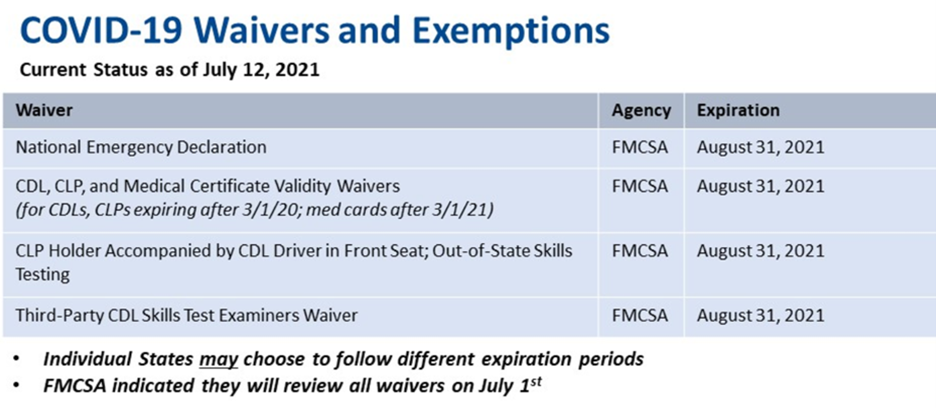
Time will tell if we're close to the post-pandemic stage, the pre-post-pandemic stage, or if we're still prolongingly entrenched in the longstanding coronavirus pandemic. From lifted mask mandates to rising vaccinations, many Americans may be much further from the terrifying realities of the pandemic than they were a year ago. However, trucking remains affected in multiple, critical ways — some impacts temporary and others long-lasting.
Impact #1: Varying regulations
The two most notable regulatory-related impacts to trucking are the longstanding Emergency Declaration and the education and awareness component of the Canadian ELD Mandate.
In March 2020, the Federal Motor Carrier Safety Administration (FMCSA) released an Emergency Declaration permitting truckers transporting emergency supplies related to the pandemic to be allowed specific exemptions relating to hours of service and other established compliance protocols. The declaration is currently in effect through August 31, 2021. Extension updates will be published here.
Additionally, the Canadian ELD Mandate went into effect on June 12, 2021. Several months prior, the Canadian Minister of Transport, the Honorable Omar Alghabra, announced the effective date would be followed by a period of education and awareness. Therefore, no enforcement penalties are currently in effect and are not expected to affect the majority of Canada until June 12, 2022. In his statement, Alghabra attributed the grace period to the pandemic, saying, "The impact of COVID-19 on commercial vehicle operations has been unprecedented and must be acknowledged."
Carriers should maximize any compliance flexibilities that apply to them and use any applicable extra time to train their teams for greater compliance success as regulations go into effect or resume standard protocols.
Below is a list of the FMCSA COVID-19 waivers and exemptions currently in place.
Impact #2: An accelerated shift to contactless everything
From movie theaters to restaurants to parking garages, many establishments have enhanced their digital transformation to provide contactless menus and payment methods that protect customers and staff alike. Trucking is no different.
Leading transportation companies quickly started looking for ways to accommodate truckers from the beginning of the pandemic with contactless mobile applications incorporating electronic proof of delivery options. As trucking keeps moving, keeping shelves and businesses stocked throughout the country, these contactless options significantly reduce the spread of germs and protect vulnerable truckers and transportation workers. With the pandemic shifting, contactless is still here to stay. It prioritizes convenience, flexibility, and safety, so carriers will find extended success with contactless optimization.
Impact #3: Shortages in abundance
The National Association of Business Economists recently stated that the labor shortage and rising prices of crucial business materials are two major obstacles for businesses through spring 2022. Both of these pandemic-related challenges are pushing businesses to pay higher prices for labor and materials. As this impacts businesses across the U.S., truckers and other fleet professionals may be affected depending on how the company they're working with is faring. Fleet leaders should utilize a beneficial strategic planning solution to optimize team capacity during fluctuating economic situations to balance loads, routes, and team capacity.
Additionally, and as we reported recently, the global microchip shortage is being referred to as the most devastating supply chain event the auto industry has witnessed in decades. The most recent projection is that the shortage will impact businesses until the first half of 2022. Class 8 trucks require anywhere between 15 to 35 microchips per vehicle, so fleet leaders looking to add new trucks to their operation may undoubtedly be impacted. Additionally, fleets responsible for transporting microchips against the tide of high-pressure demand must ensure they do so efficiently and safely. Effective routing and dispatching solutions will work especially well in this situation. They enable you to input multiple stops in unison with reliable routing algorithms that account for time, traffic, and your teams.
Impact #4: Lingering unease
Depending on the country, state, province, official, medical professional, or person on the street you ask, everyone will have different assumptions about which stage of the pandemic we're occupying. The phrase post-pandemic has been out in full force in the U.S., with 56% of those ages 12 and up fully vaccinated, as of July 19, 2021.
As the sighs of relief came, so did Delta developments. Variants, like the contagious Delta variant, are spreading — specifically amongst the unvaccinated, including children under 12 who aren't eligible to take the vaccine yet. The Delta variant is a metaphor for the unpredictability that has shaped the COVID-19 pandemic. All of this is to say that fleets and transportation leaders must continue keeping their eyes and ears open for substantial public health shifts, working on pivoting processes in place with fleet intelligence solutions that can evolve with their business at speed.
Uncover what our data findings reveal about the coronavirus' impact on trucking in our conversation with Omnitracs Chief Data and AI Officer Dr. Ashim Bose.

